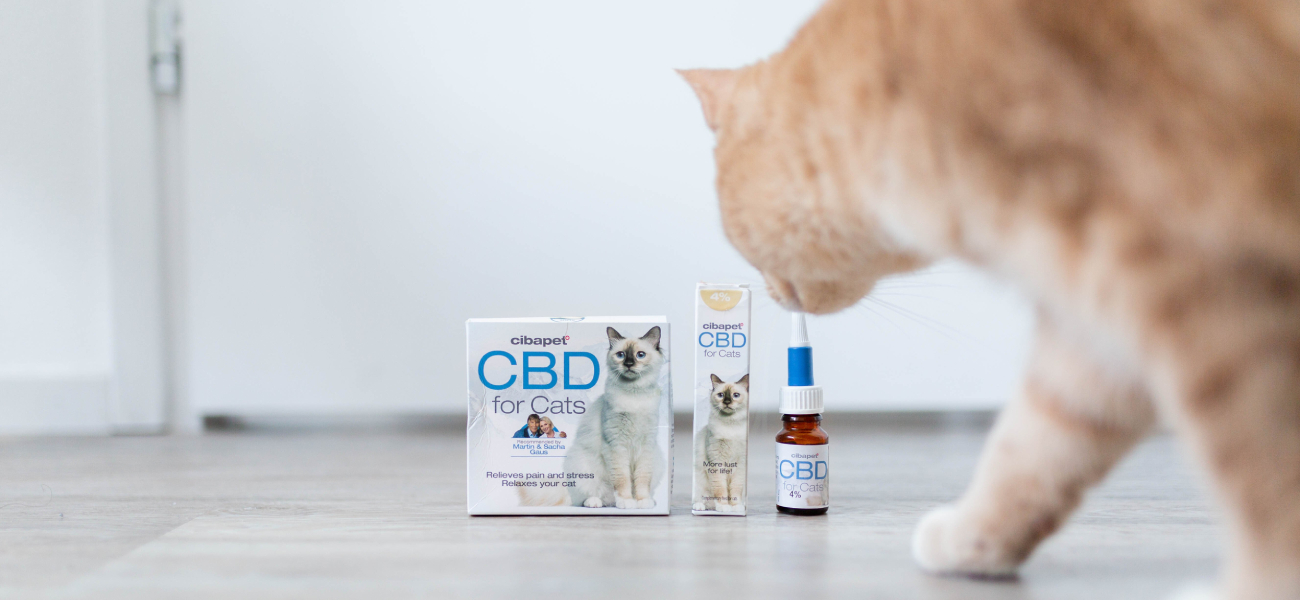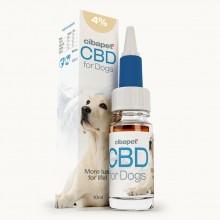CBD for Pets: All You Need To Know

CBD may be a popular wellness supplement for humans, but we aren't the only ones that could benefit from its balancing influence. Keep reading to find out what impact CBD has on cats and dogs, and how to find the best product for your beloved companion.
Contents:
What is CBD for pets?
The title may seem self-explanatory, but, if you're new to CBD, you'll be surprised to learn it exists for pets too. Put simply, CBD for pets is a range of pet products infused with specially formulated CBD extract. The selection is ever-growing, but common items include CBD oil, CBD pastilles, and CBD treats.
While CBD pet products still use CBD as a major ingredient, there are subtle differences in the formula from CBD products meant for humans. We'll cover these changes in more detail shortly, but it's important to note that unless a CBD product states it’s exclusively for pets, it won't be suitable for your cat or dog.
How does CBD for pets work?
To understand how CBD works in pets, it's essential to know how cannabinoids (the group of molecules CBD belongs to) interact with their biological systems in general. Fortunately, there are several similarities between our physiology and our furry friends’.
Your pet also possesses an endocannabinoid system (ECS), a vast network of receptors that monitors well-being. When consumed as an oil or treat, CBD is processed by your pet's digestive system and liver before being distributed around the body.
The ECS reacts to the presence of CBD and other cannabinoids, and can trigger a wide range of potential outcomes—just like it does in humans. Researchers are still exploring the full extent of the ECS[1] in cats and dogs, but so far they've uncovered the following:
• Cats and dogs have CB1 and CB2 receptors
• CB1 receptors have been found in salivary glands, hair follicles, skin, and parts of the brain
• The majority of CB2 receptors are located in your pet's skin
• Some CB receptors appear to have a similar function to those found in humans and rodents
Are the effects of CBD the same for humans and pets?
The last point highlighted above is important. Some CB receptors found in pets have a similar function to the ones in our own body. This means there's likely crossover between how we feel when we take CBD, and the impact on our canine and feline companions.
In dogs, researchers believe ECS stimulation could suppress pro-inflammatory cells while supporting overall skin and joint health[2]. There's also some evidence to suggest a link between CBD intake and neurological conditions[3].
In cats, studies show similar outcomes. Joint and skin health appear impacted by CBD, as do certain oral conditions[4]. Interestingly, research into CB1 receptors shows CBD may affect muscle function—a different outcome to the canine studies above.
Terpenes and pets
We alluded to this earlier, but CBD pet products differ from human offerings. Although the extract remains packed with golden-grade CBD and select cannabinoids, the key difference is the lack of terpenes.
Although terpenes play a crucial role in the entourage effect (a phenomenon that improves the efficacy of full-spectrum CBD extracts), they can be overpowering for animals. With senses over 10,000x more acute than our own, what smells or tastes mild to us is a sensory overload to our pets!
Animals may find the taste and smell of terpenes unpleasant, so, for a seamless experience, we carefully remove terpenes from all Cibdol CBD for pets products.
How do I give my pet CBD?

With the fundamentals of CBD for pets covered, it's time for the most critical part—adding CBD to their daily routine! We know all pets are different, and that's why we offer several ways to incorporate it. From CBD oil to CBD treats, there's bound to be an option they'll love—no matter your pet's age or sensitivity.
CBD oil for pets
Like humans, cats and dogs enjoy the most popular type of CBD formula: CBD oil.
CBD oil for pets is usually administered onto their food or mixed with water. There's no reason you can't apply drops directly, but we know that's often easier said than done.
CBD oil for pets also comes in two concentrations. Both are much milder than human alternatives, but don't worry; they should still be just as effective. Don't forget, our canine and feline companions are much smaller than us, and weight plays a role in CBD's impact.
What is the ideal dose of CBD oil for my pet?
The most suitable dose will depend entirely on your pet’s age, sensitivity, and wellness needs. But, given CBD's lack of toxicity in pets, it's easy to start with a low dose and build until you reach the desired effect. Start with a few drops or a single treat with every meal. Maintain the same dose for roughly two weeks before increasing as needed.
CBD pastilles and treats for pets
CBD treats and pastilles provide a standard dose of CBD that, depending on your pet, may be more convenient to administer than CBD oil. Each treat features the same specially formulated CBD extract, but with extra ingredients (for flavour). It's common for owners to add CBD pastilles to a pet’s mealtime, but you can also use them as a standalone treat.

CBD and pets: Is it safe?
Pet safety is at the top of every owner’s agenda, and the evidence appears positive when it comes to CBD's impact on cats and dogs. However, it's important to remember that, just like humans, every pet is different. Even pets of the same age and breed may differ slightly in their endocannabinoid system.
How your cat or dog reacts to CBD will be unique to them, so it's crucial to start slow. Research on CBD's interaction with pets is still in its infancy, and much more testing needs to occur to confirm what we’ve learned thus far. In the meantime, choose CBD pet products from reputable companies, such as Cibdol, to bypass the risk associated with low-quality CBD. Just like our traditional ranges, we independently test all CBD pet products to provide the highest quality possible.
To explore our full range of CBD cat and dog products, why not browse the Cibdol store? Or, if you still have questions about CBD, terpenes, and independent testing, find the answers in our comprehensive CBD Encyclopedia.
[1] Silver, R. J. (2019). The Endocannabinoid System of Animals. NCBI. https://www.ncbi.nlm.nih.gov/pmc/articles/PMC6770351/ [Source]
[2] Gamble, L., Boesch, J. M., & Frye, C. W. (2018). Pharmacokinetics, Safety, and Clinical Efficacy of Cannabidiol Treatment in Osteoarthritic Dogs. PubMed. https://pubmed.ncbi.nlm.nih.gov/30083539/ [Source]
[3] McGrath, S., Bartner, L. R., & Rao, S. (2019). Randomized blinded controlled clinical trial to assess the effect of oral cannabidiol administration in addition to conventional antiepileptic treatment on seizure frequency in dogs with intractable idiopathic epilepsy. PubMed. https://pubmed.ncbi.nlm.nih.gov/31067185/ [Source]
[4] Polidoro, G., Galiazzo, G., & Giancola, F. (2020). Expression of cannabinoid and cannabinoid-related receptors in the oral mucosa of healthy cats and cats with chronic gingivostomatitis. SAGE Journals. https://journals.sagepub.com/doi/abs/10.1177/1098612X20970510 [Source]
[1] Silver, R. J. (2019). The Endocannabinoid System of Animals. NCBI. https://www.ncbi.nlm.nih.gov/pmc/articles/PMC6770351/ [Source]
[2] Gamble, L., Boesch, J. M., & Frye, C. W. (2018). Pharmacokinetics, Safety, and Clinical Efficacy of Cannabidiol Treatment in Osteoarthritic Dogs. PubMed. https://pubmed.ncbi.nlm.nih.gov/30083539/ [Source]
[3] McGrath, S., Bartner, L. R., & Rao, S. (2019). Randomized blinded controlled clinical trial to assess the effect of oral cannabidiol administration in addition to conventional antiepileptic treatment on seizure frequency in dogs with intractable idiopathic epilepsy. PubMed. https://pubmed.ncbi.nlm.nih.gov/31067185/ [Source]
[4] Polidoro, G., Galiazzo, G., & Giancola, F. (2020). Expression of cannabinoid and cannabinoid-related receptors in the oral mucosa of healthy cats and cats with chronic gingivostomatitis. SAGE Journals. https://journals.sagepub.com/doi/abs/10.1177/1098612X20970510 [Source]













